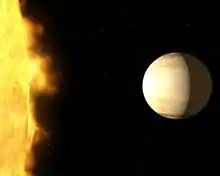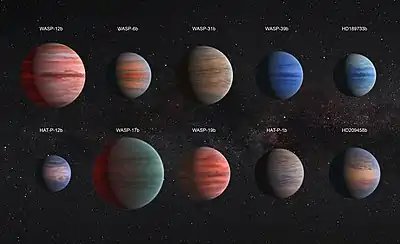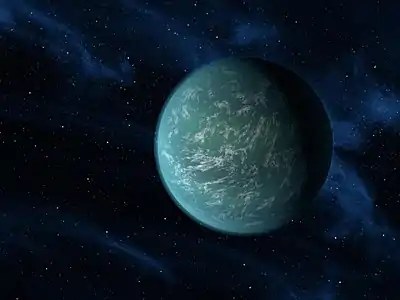WASP-39b
WASP-39b is a "hot Jupiter" extrasolar planet discovered in February 2011[3] by the WASP project, notable for containing a substantial amount of water in its atmosphere.[1][4][5] WASP-39b is in the Virgo constellation, and is about 700 light-years from Earth.[1]
 Exoplanet WASP-39b found to contain substantial amounts of water in its atmosphere. (artist concept)[1] | |
| Discovery | |
|---|---|
| Discovery site | WASP[2] |
| Discovery date | 2011[2] |
| Primary transit[2] | |
| Orbital characteristics | |
| 0.0486±0.0005 AU | |
| Eccentricity | 0[2] |
| 4.05526[2] d | |
| Inclination | 87.83±0.25[2] |
| Star | WASP-39[2] |
| Physical characteristics | |
Mean radius | 1.27±0.04[2] RJ |
| Mass | 0.28±0.03[2] MJ |
Mean density | 180±40 kg m−3 |
As part of the NameExoWorlds campaigns at the 100th anniversary of the IAU, the planet was named Bocaprins, by Aruba. The planet is named after the beach Boca Prins in the Arikok National Park. The star WASP-39 was named Malmok.[6][7]
Characteristics

WASP-39b has a mass of about 0.28 times that of Jupiter and a radius about 1.27 times that of Jupiter.[2] The exoplanet orbits WASP-39, its host star, every 4 days.[1] Hot water molecules were found in the atmosphere of WASP-39b in a 2018 study.[1]
WASP-39b is also notable for having an extremely low density, near that of WASP-17b. While WASP-17b has a density of 0.13±0.06 g/cm3, WASP-39b has a slightly higher density of 0.18±0.04 g/cm3.
References
- Cofield, Calla; Jenkins, Ann; Villard, Ray (1 March 2018). "NASA Finds a Large Amount of Water in an Exoplanet's Atmosphere". NASA. Retrieved 3 March 2018.
- "Planet WASP-39 b". Extrasolar Planets Encyclopaedia. 2018. Retrieved 1 March 2018.
- WASP-39b: a highly inflated Saturn-mass planet orbiting a late G-type star, 2011, arXiv:1102.1275
- H. R. Wakeford, D. K. Sing, D. Deming, et al (21 December 2017). "The Complete Transmission Spectrum of WASP-39b with a Precise Water Constraint". The Astronomical Journal. 155 (1): 29. arXiv:1711.10529. doi:10.3847/1538-3881/aa9e4e.CS1 maint: multiple names: authors list (link)
- "NASA finds a large amount of water in an exoplanet's atmosphere". Phys.org. 1 March 2018. Retrieved 1 March 2018.
- "Approved names". NameExoworlds. Retrieved 2 January 2020.
- "International Astronomical Union | IAU". www.iau.org. Retrieved 2 January 2020.
External links
![]() Media related to WASP-39b at Wikimedia Commons
Media related to WASP-39b at Wikimedia Commons


.jpg.webp)
